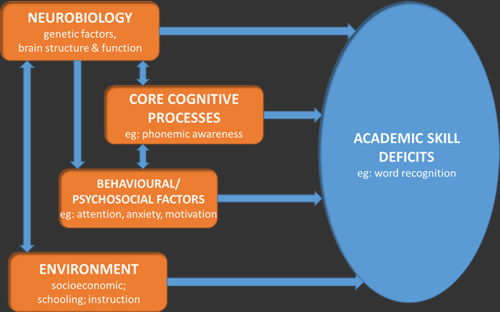#1: DYSLEXIA IS: a neuro-developmental disorder with a biological origin and behavioural signs which extend far beyond problems with the written language.
Frith, U., 1999, Paradoxes in the definition of dyslexia, Dyslexia, 5, 192-214;
#2: DYSLEXIA IS: commonly understood as a myth, and may be regarded as merely a middleclass excuse for laziness. Dispatches:
‘The Dyslexia Myth’, Broadcast 8th December 2005: directed by Mills, D., UK, Channel 4 Television;
#3: DYSLEXIA IS: a disorder manifested by difficulty in learning to read despite conventional instruction, adequate intelligence and sociocultural opportunity; dependent on fundamental cognitive abilities, frequently constitutional in origin.
World Federation of Neurology, 1968, variously reported;
#4: DYSLEXIA IS: a specific condition of primary constitutional reading difficulty which may occur electively and which, in its pure form, differs distinctively from other reading difficulties.
Eichenwald, H.F., 1967, The pathology of reading disorders: Psycholpathological factors. In: Johnon, M., Kress, R. (eds) Corrective reading in the primary classroom Newark, International Reading Association;
#5: DYSLEXIA IS: a combination of abilities and difficulties that affect the learning process in one or more of reading, spelling or writing and may have accompanying weaknesses in processing speed, short-term memory, organization and sequencing.
Peer, L., 2006, British Dyslexia Association Code of Practice for Employers, Bracknell, BDA;
#6: DYSLEXIA IS: a developmental language disorder that involves deficits in phonological processing.
Catts, H.W., 1989, Defining dyslexia as a developmental language disorder, Annals of Dyslexia, 39, 50-64;
#7: DYSLEXIA IS: an experience that arises out of natural human diversity in a world where the early learning of literacy, of good personal organization and of fast working memory are mistakenly used as markers of intelligence.
Cooper, R., 2006, A social model of dyslexia, Language Issues 18(2), 24;
#8: DYSLEXIA IS: a processing difference experienced by people of all ages, often #8 characterized by difficulties in literacy; it can affect other cognitive areas such as memory, processing speed, time management, co-ordination and directional aspects.
Reid, G., 2003, Dyslexia: A practitioner’s handbook, Chichester, John Wiley & Sons;
#9: DYSLEXIA IS: a specific learning disability, neurological in origin, characterized by difficulties with accurate and/or fluent word recognition, poor spelling and decoding abilities, typically resulting from a deficit in the phonological component of language.
Bright Solutions for Dyslexia, 2014, Available at: http://www.dys-add.com/dyslexia.html#anchorDefinition, Accessed on: 30th March 2015;
#10: DYSLEXIA IS: a disturbance in certain linguistic functions when written language is decoded. It is expressed as difficulties in achieving an automized word recognition during reading, includes poor spelling, often runs in families and tends to persist.
Lundberg, I., 1999, Towards a sharper definition of dyslexia, In: Lundberg, I., Tonnessen, F., Austad, I (eds), Dyslexia: Advances in theory and practice, Netherlands, Springer;
Dyslexia is ...?
- Rice & Brooks (2004) concluded that interest in dyslexia over many decades of research has produced a persistent range of methodologies and a componding variety of interpretations that continue to be problematic. Hence attributing any shared meaning to the dyslexia label that is helpful rather than confusing continues to be challenging.
- Theories of developmental dyslexia still differ quite widely, especially when it comes down to interpreting causes for the variety of characteristics that can be presented (Ramus, 2004) and that well over a century of research, postulation, commentary, narrative and theory has consistently failed to arrive at an end-point definition to the dyslexia label (Smythe, 2011).
ACTIVITY - ordering 10 definitions of dyslexia from 'most preferred' to 'least preferred'
- So defining dyslexia as a starting point for an investigation is challenging and this causes problems for the researcher because the focus of the study ought to be supported by a common understanding of the topic of interest.
- What seems clear and does meet with general agreement is that at school-age level, difficulties experienced in phonological processing and the 'normal' development of word recognition automaticity appear to be the root causes of the slow uptake of reading skills and associated challenges with spelling.
- Whether this is caused by a dyslexia of some description or is simply unexplained poor reading may be difficult to determine.
- For learners of above average academic ability but who indicate dyslexia-associated learning challenges, it is reasonable to expect these learners to strive to extend their education to post-compulsory levels along with their academic peers despite the challenges they may face in a literacy-based education system which may be due to their learning differences.
- Fletcher (2009), in trying to bring together a summary of more recent scientific understanding of dyslexia, attemps to visualize the competing/contributory factors that constitute a dyslexic profile in a summary diagram which is helpful:

- Fletcher adds a dimension to those previously identified by Frith (1999) and Ramus et al (op cit) by factoring in environmental influences, not least which includes social aspects of learning environments which are likely to be the most impacting factor on learning identity. Mortimore & Crozier (2006) demonstrated that acceptance of dyslexia as part of their learning identity was often something that students new to uniersity were unwilling to embrace, often because they felt that the 'fresh start' of a tertiary educational opportunity would enable them to adopt other more acceptable social-learning identities that were deemed more inviting.
